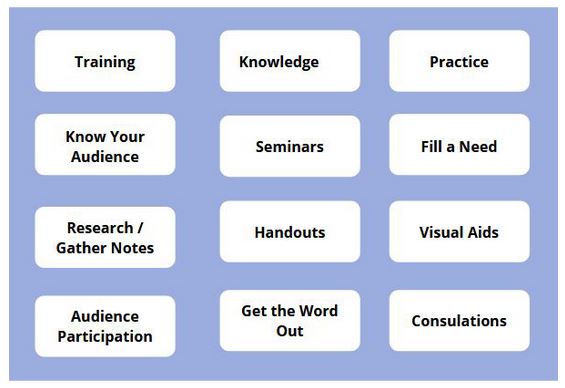
by Stephen Tremp
You’ve just bumped into that one person who has the power to say yes and all your dreams become a reality. You have 30 seconds. Knowing what to say makes the difference between that all might word YES or yet one more rejection from someone who can open doors of opportunities you can’t.
Cramming a bunch of words into a half minute will not work. You’ll lose your audience as you nervously take a deep breath then rattle off something you hope resembles any of the following:
- An executive summary
- 30 second elevator pitch
- blurbs
- taglines
- other summaries
The first thing you need to do is immediately, and this is vital to your success, provide your listener a structure in which whatever you say during the next 30 seconds, they’ll be able to fit into a framework and make sense of it. Attention is the new currency, and just like I’m doing right now, you need to be able to grab people’s attention right away.
I’m Stephen Tremp and I’m going to show you how you can create a framework whereby your audience can receive and remember everything you say during the next 30 seconds and left wanting to hear more. Then I’ll include public speaking tips that help me to present content to my audience and I’m sharing them with you.
 Here was a memorable example from my children’s early school days. One of my kids, when she was in the fourth grade, had to give an oral book report for a story called The Orphan Train. It was her first such assignment and she told me she was very nervous she would not have an interesting or exciting presentation and she did not want to fail in front of her entire class.
Here was a memorable example from my children’s early school days. One of my kids, when she was in the fourth grade, had to give an oral book report for a story called The Orphan Train. It was her first such assignment and she told me she was very nervous she would not have an interesting or exciting presentation and she did not want to fail in front of her entire class.
So, I asked her to stand in front of the fireplace and do a rehearsal. She lost me within the first 30 seconds. She started at the very beginning of her presentation and stumbled forward trying to explain everything about everything.
I smiled (she needed daddy encouragement) and told her, “Your knowledge of the story and your written notes are great. I see you put in hard work to make your report a success.
However, you need to capture your audience’s attention in the first moments of your report or you’ll lose them and you won’t get them back.”
She needed a one sentence synopsis. Together we came up with a simple opening line:
"The Orphan Train is based on true events 150 years ago when tens of thousands of orphan street children in New York City were sent to the Midwest in search of a better life."
Fortunately she could use 5 X 7 note cards and wrote her synopsis on one and rehearsed it until she felt comfortable saying it in front of her class.
The next day when I picked her up she was happy to tell me her oral book report was a great success. The kids listened attentively to her every word. They asked questions, and when she was finished she was given an excellent grade.
Provide your listener a structure in which whatever you say during the next 30 seconds and they’ll be able to fit into a framework and make sense of it.
Tips Tricks and Ideas to Becoming a Great Public Speaker
Okay, you have more on your plate than a quick pitch to put together. You still need to deliver your content to your audience in a way that is confident, professional and leaves them wanting more.
First things first. Ask yourself a few questions before diving into developing a 30-second pitch and a one sentence synopsis.
How are you at public speaking? Everyone is good at something when speaking to a group of people.
What do you want to accomplish with your speaking? And why?
What credentials do you have or can you gain to use and give yourself credibility?
List all places you can drive to that could host a speaking event such as schools, libraries, festivals, professional organizations, clubs, radio, television, webinars, etc.
Do you mind doing public speaking for free until you get to the place you are confident you can charge money? This will build your confidence and help build your resume.
Do you mind doing public speaking for free until you get to the place you are confident you can charge money? This will build your confidence and help build your resume
Once you have determined your public speaking strengths and weaknesses you can identify various approaches that will help you better communicate your message and not lose your audience and that all important currency of attention.

Training
Learn and master the skills needed to speak in public. Find your local Toastmasters and take advantage of learning to speak in front of a live audience in a safe and secure environment. Most colleges offer a course on public speaking, including community colleges. You can also hire a media coach for private training sessions.
Knowledge
Know your topic and research it in depth. Take notes and organize them into a natural flow. The better you know your subject, the more confidence you’ll possess. You need to offer something of value to the listeners and they have to believe you are the one to deliver the goods to them.
Practice
Run through your talk many times. Don’t memorize – your notes should be an outline. You need to determine your best delivery and the length of your talk. Record yourself and listen for problem areas.
Know Your Audience
Before you speak, learn about the group. You can then tailor your talk to fit their needs.
Seminars
Seminars are another great way to generate income. A seminar can be anywhere from one hour to a full day event. They are more detailed than a talk and require more planning and research. But if you are an expert in any given field, you can use a seminar to impart your wisdom to others.
The venue for a seminar is much the same as for a talk. They can be a special training program at a library, a small business center seminar through a community college, a session at a conference, or even a special event held at a hotel conference room or other location.
Fill a Need
Find out what knowledge you possess that others want. Research venues, businesses, conferences, schools, etc. to see where your subject would be a good fit. Make a list of contacts.
Research and Gather Your Notes
Organize the information into an outline that flows well. Reference resources such as websites, books, and organizations.
Handouts
Create an outline of your event for attendees. Be sure to list resources and provide a glossary if needed.
Visual Aids
Design a PowerPoint presentation, gather visual aids or create a demonstration.
Audience Participation Make your seminar interactive. Get attendees involved. Ask questions and solicit responses. If your audience is silent you may have to point someone out at random and ask a question. Don’t hesitate to ask them to stand and give a response.
Get the Word Out
Once you’ve set an event, be its biggest promoter.
Promotional Material
Have business cards, brochures, etc. for attendees to take with them when it’s over.
Consultations
Another way to gain exposure and share your knowledge and skills is through consultations. These sessions can be offered one-on-one or in a group setting. Consultations can be conducted in person, over the phone, via email, or through the Internet with worksheets, interactive content, and videos. They can be a one-time meeting or span several sessions.
A simple consultation might involve a form the person fills out from which you analyze and offer recommendations. A more complex meeting might involve creating worksheets or exercises for participants to follow over the course of days or weeks. As with seminars, this requires careful planning. Consultation fees vary. Keep in mind your time is valuable but don’t over-price your services
Your Fee
If applicable set a reasonable fee, either for attendees or for the venue or organization sponsoring your event.
You can see the benefits of becoming a great public speaker. You can reach your current target audience, find new ones and scale up your business.
Call to Action
Your call to action is to write a 30-second pitch then create a one sentence synopsis. If you need inspiration, I suggest IMDB the world’s most popular and authoritative source for movie TV and celebrity content.
 For example, try explaining Game of Thrones in 30 seconds or less. Good luck with that. It’s much easier if you start with a one-line synopsis like IMDb does:
For example, try explaining Game of Thrones in 30 seconds or less. Good luck with that. It’s much easier if you start with a one-line synopsis like IMDb does:
9 noble families fight for control over the mythical land of Westeros while a forgotten race returns after being dormant for thousands of years.
Now your audience can frame your 30-second pitch into this one synopsis and make sense of it. This is a win-win for you and your audience.